A Hyperrealist Artist Draws The Dying To Understand Life
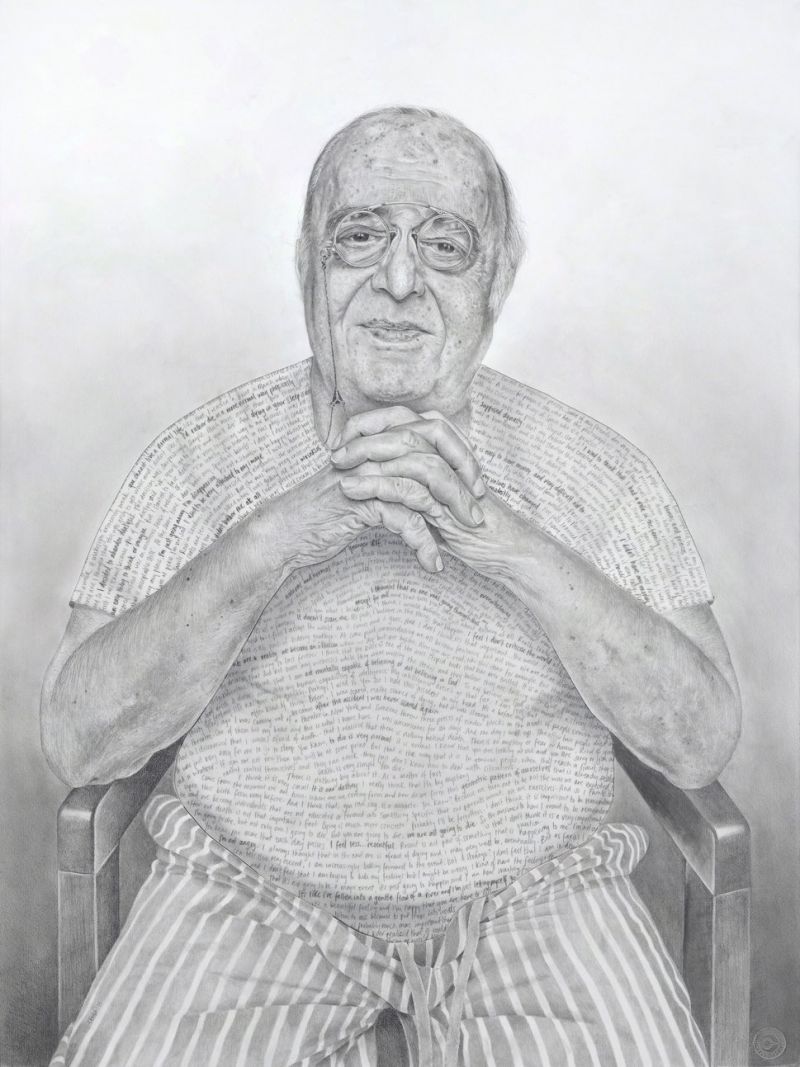
CLAUDIA BICEN, DANIEL - PENCIL ON DRAWING AND TISSUE PAPERS - 30” X 22”
“Introduced through Hospice by the Bay, Daniel and I met weekly in his room in a high-rise SRO block in San Francisco’s SOMA. A graduate of Harvard University and friends with Spanish royalty, Daniel lost all of his wealth when he was cut out of his father’s business empire and struggled with mental health issues. Now sharing hallways with the city’s most disenfranchised residents, Daniel would still go for caviar and champagne once a week using money from his estranged son. Daniel was adamant that death did not trouble him and that he was simply letting the “gentle flow of a river” carry him towards the end. Several weeks after our interviews were completed, I went to visit him at Coming Home Hospice in San Francisco. In floods of tears and wrecked with terror, Daniel held onto me like a child. The next day, on July 22, 2015, Daniel died alone in his room.”
Artist Claudia Bicen spent two years meeting with, interviewing and drawing individuals approaching the ends of their lives. In order to answer an oft-pondered question — “How should I live?” — she felt strongly that the dying would have the answer. So she contacted hospices across the Bay Area in California, eventually selecting nine men and women who would become the subjects of her heart-wrenching series, “Thoughts in Passing.”
“In making this work I came to observe a profound paradox: in talking with me about dying, these people taught me how to live more meaningfully and more intensely,” she writes in a statement on her website. “I found that, for most people, what mattered was how they had participated in the world and what they had created — whether that was through connection with their children, community, work or nature. Though I spoke with people from a wide range of socio-economic backgrounds, nobody wished they had made more money, worked harder or bought more things.”
The works in “Thoughts in Passing,” nine life-size graphite pencil portraits, not only illuminate the faces of people like Daniel, Ena, Osamu and Jenny, but their words too. Scrawled within the hyperrealist images are the narratives told to Bicen, the slight text hidden in the folds of a t-shirt or the rolls of a sleeve. Bicen has collected their recorded conversations on Vimeo, where you can hear the reflections, regrets and lessons in the subjects’ own voices.
Ena from Claudia Bicen on Vimeo.
We reached out to Bicen to hear more about her provocative series:
You write online that you’ve always been “transfixed by the question of how we should live”? How so?
From 14 years old, I started to write to my future self each New Year’s Eve and open the letters a year later. I wanted to understand my change through time, but more broadly to create a project that documented one person throughout a lifetime. Sixteen years later I am still grappling with some of the same personal struggles as I always did, but now I can just see their persistence more clearly.
As I grew up, I sought answers to the question of how we should live from many people and traditions across the world and through history. Formally, I have degrees in psychology, philosophy and anthropology but informally I have spent much time studying the world’s spiritual traditions and practicing meditation. Outside of the books, my journey has led me to connect with many people who have gone through and continue to go through trauma, be it suicide attempts, addiction, HIV/AIDs, abuse or homelessness.
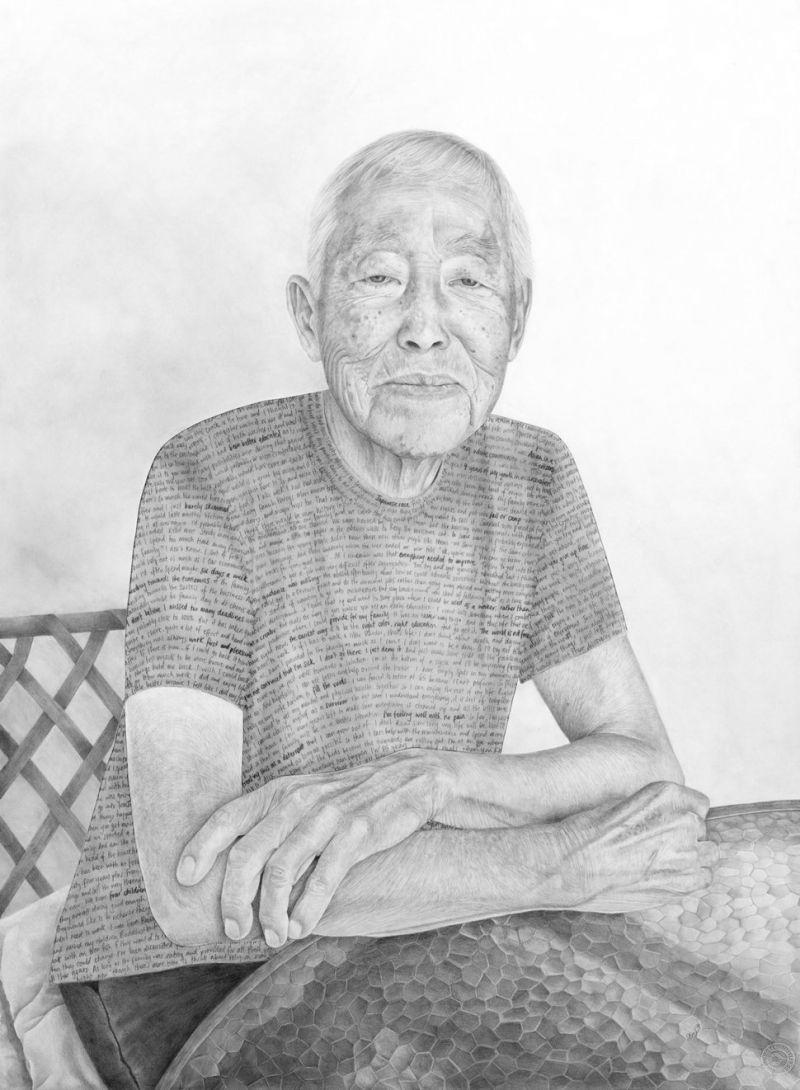 CLAUDIA BICEN, OSAMU - PENCIL ON DRAWING AND TISSUE PAPERS - 30” X 22”
CLAUDIA BICEN, OSAMU - PENCIL ON DRAWING AND TISSUE PAPERS - 30” X 22”
“Osamu and I met in his home in Moraga through the Asian Network Pacific Home Care. Throughout our interviews, Osamu denied that he was dying and told me that he refused to “go there” psychologically. Instead he spent his time with me talking about his childhood years in a Japanese internment camp in California during WW2. Not only was Osamu set back by being taken out of the education system throughout the war, like other Japanese people at the time, he was to suffer from widespread discrimination. He lamented upon the cultural ceiling this created and how his life choices had to be focused on financially providing for a family rather than following his passions.”
You also note that you were convinced that the dying would have the answer — why did you think this?
When Plato was on his deathbed, he was approached by one of his students who asked him to sum up the entirety of his life’s work. His response was: “practice dying.” An awareness of our death not only reminds us of our own impermanence, but the impermanence of absolutely everything. Living with a deep experiential knowledge of this truth cannot help but have an effect on the way you interact with people and the world around you. I wanted to talk to people who were dying because I believed their imminent death would teach them lessons about life. I thought the knowledge that time was running out might make people look differently at their past, present and future. And it did ... sometimes.
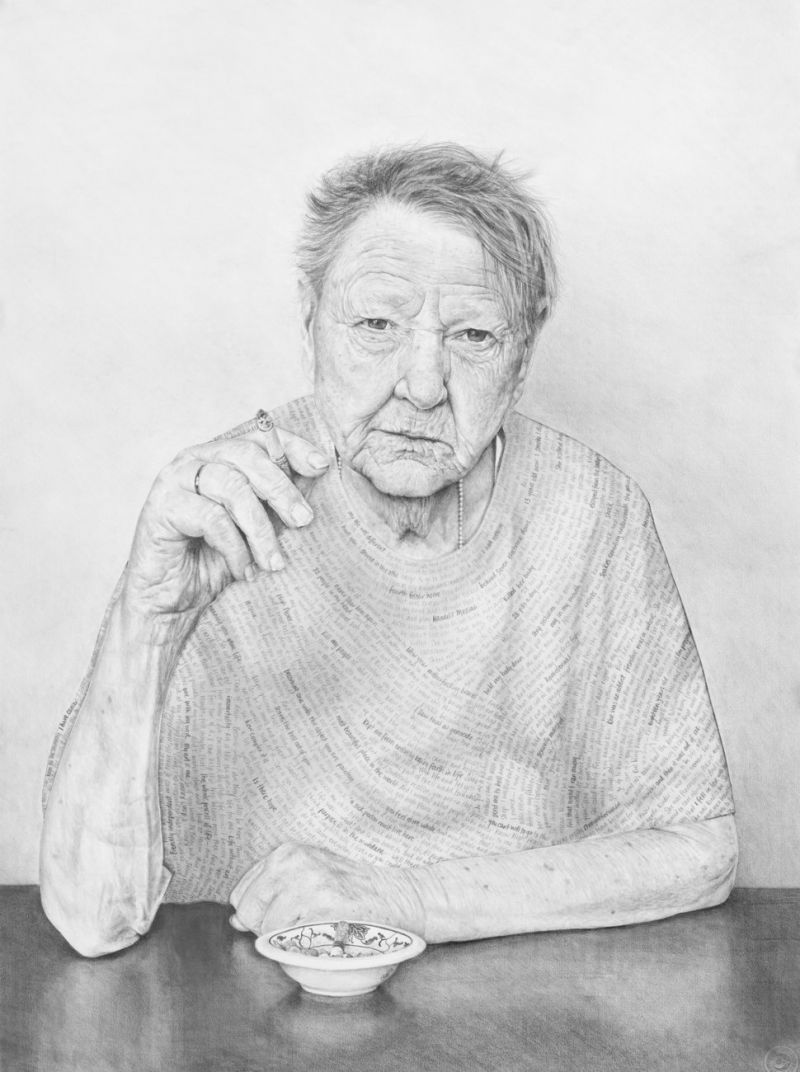 CLAUDIA BICEN, JENNY MILLER - PENCIL ON TRACING PAPER AND PAPER 29” X 21.5”
CLAUDIA BICEN, JENNY MILLER - PENCIL ON TRACING PAPER AND PAPER 29” X 21.5”
“When I met Jenny through Pathways Hospice, she was living in an SRO building in San Francisco’s Tenderloin district. Surrounded by a lifetime’s work of stunningly intricate paintings and sculptures, Jenny would monologue for an hour, stopping only to light another cigarette and slurp on her grape soda. Jenny was an artist in the purest form: she was compelled to create and she did so in order to heal herself. Jenny explained that all the way through her life – through physical and sexual abuse, hospitalization, mental illness and homelessness – art had been the thing that saved her. In September 2015, Jenny’s portrait was selected be exhibited at the Smithsonian Institution in Washington DC. When Jenny and I went out for lunch to celebrate, she told me that participating in this project had validated her life.”
How did you decide to contact hospices in particular?
I wanted to work with people who knew they only had a short time left to live so hospices felt like the appropriate place to start. Unlike in palliative care, people who are in hospice are no longer receiving curative treatment for their illness and are thought to have less than six months to live.
How did you decide to go about drawing them?
I decided to use graphite pencil for this project because it felt softer and more solemn than color, and I made the pieces life size because I wanted the viewer to feel like that person was really in front of them. I transcribed roughly 3000 words of my conversations with each person onto their clothing in the portraits. The thinking behind this was two fold. Firstly, the script on the clothing would serve as a metaphor for the stories we “carry” and construct our sense of self with. Secondly, I hoped the intricate text would encourage the viewer to come close and spend time with the portrait, providing a kind of intimacy with the work. The audio clips were not part of the original conception, but as soon as I started recording I knew their voices needed to be heard.
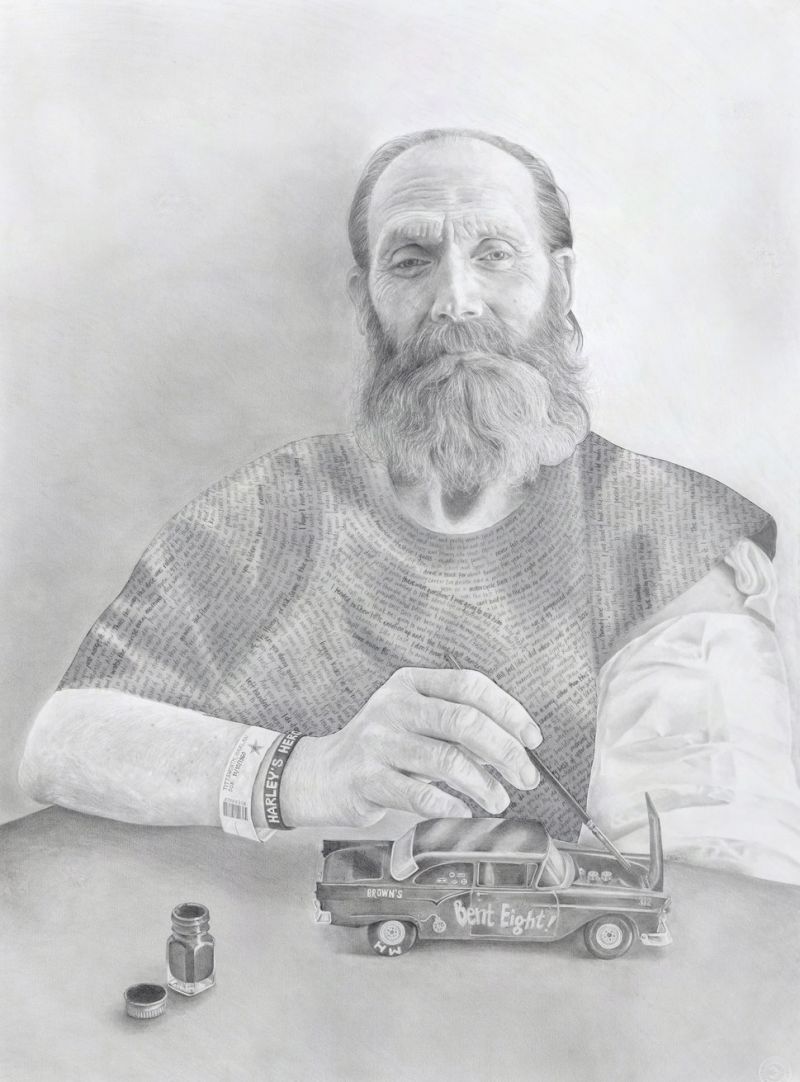 CLAUDIA BICEN, HARLAN - PENCIL ON DRAWING AND TISSUE PAPERS - 30” X 22”
CLAUDIA BICEN, HARLAN - PENCIL ON DRAWING AND TISSUE PAPERS - 30” X 22”
“When I met Harlan, he had been a resident at the VA Medical Center in Livermore for more than three years. Harlan grew up on a farm in Central California where he learned to hot-rod cars and fix up motorcycles. The tumors consuming his left arm were thought to be the consequence of decades of driving a truck in the California sun. No longer able to drive fast cars, Harlan taught himself to build and paint model vehicles with his non-writing hand. As the boundaries of his world closed in on him, Harlan continually found new ways to create meaning in his life. Once a self-proclaimed unemotional man, Harlan opened up his life to me and shared his deepest regrets and fears. Harlan died on November 2, 2014.”
How did you choose the nine subjects you interviewed and drew for the project?
I contacted 10 hospices across the Bay Area and word was put out to social workers, nurses and chaplains that I was looking for patients to participate in an art project about confronting mortality. Initially, I decided that I would accept anyone for the project who wanted to take part, but as time went on I realized I needed to turn some people away in order to maintain space for diversity. There were also a number of people I tried to work with who died too soon, and there were others I met but were not open to talking about the fact they were dying.
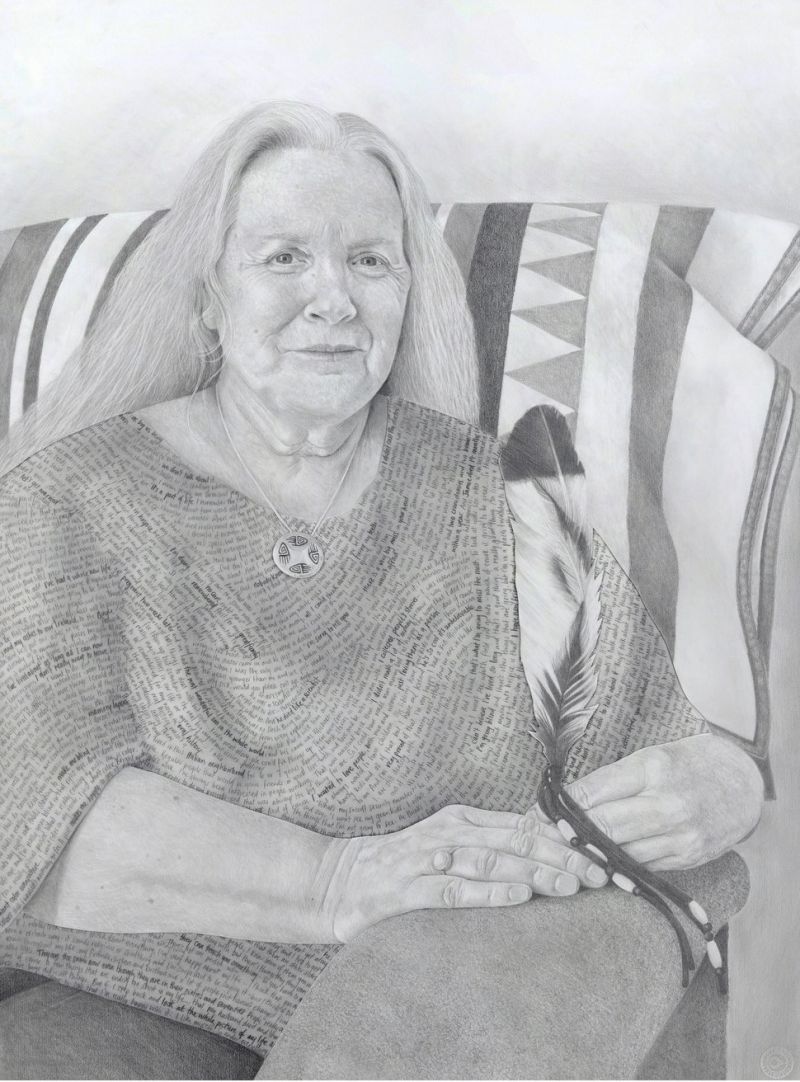 CLAUDIA BICEN, JUDITH - PENCIL ON DRAWING AND TISSUE PAPERS - 30” X 22”
CLAUDIA BICEN, JUDITH - PENCIL ON DRAWING AND TISSUE PAPERS - 30” X 22”
“Judith and I met at Zen Hospice Project in Hayes Valley, San Francisco. A Boston native, Judith moved to the Bay Area as a young woman where she pursued a career as an oral historian, working with illiterate communities in the East Bay. Judith’s room at the hospice was filled with colorful items, objects of meaning and new things that made her happy. She might have been dying, but she was still alive, and each week she would tell me of new friendships she was making. Judith had the same brain cancer her husband died of and she knew that when she died she would be leaving her young son behind with no parents. With deep love for her son, she committed herself to ensuring that they communicated openly and honestly about what they were both experiencing.”
In the description online, you conclude that, “in short, [the subjects] were not concerned with what they consumed and took into themselves” and that meaning, for them, came from creation and not consumption. Did the subjects express regret at all?
A lot of my subjects expressed regret, but not all. In particular, regret is a strong theme in the portraits of Harlan, Osamu and Ena. Both Harlan and Osamu regretted how much time they spent working and its impact on the quality of their lives. Harlan lamented that he had worked so much overtime to earn more money, and wished instead that he had been with his family. Osamu regretted making a career choice in order to be the provider, and wished he had more time for his family, education and creativity. In contrast, Ena dedicated her professional and personal life to helping people, and wished that she had made more time to follow her own dreams. She felt she sacrificed opportunities in order to support her husband, parents, brother, etc. I think the regrets of Harlan, Osamu and Ena are in part a reflection of the gender paradigms of our culture that impact the lives of both women and men.
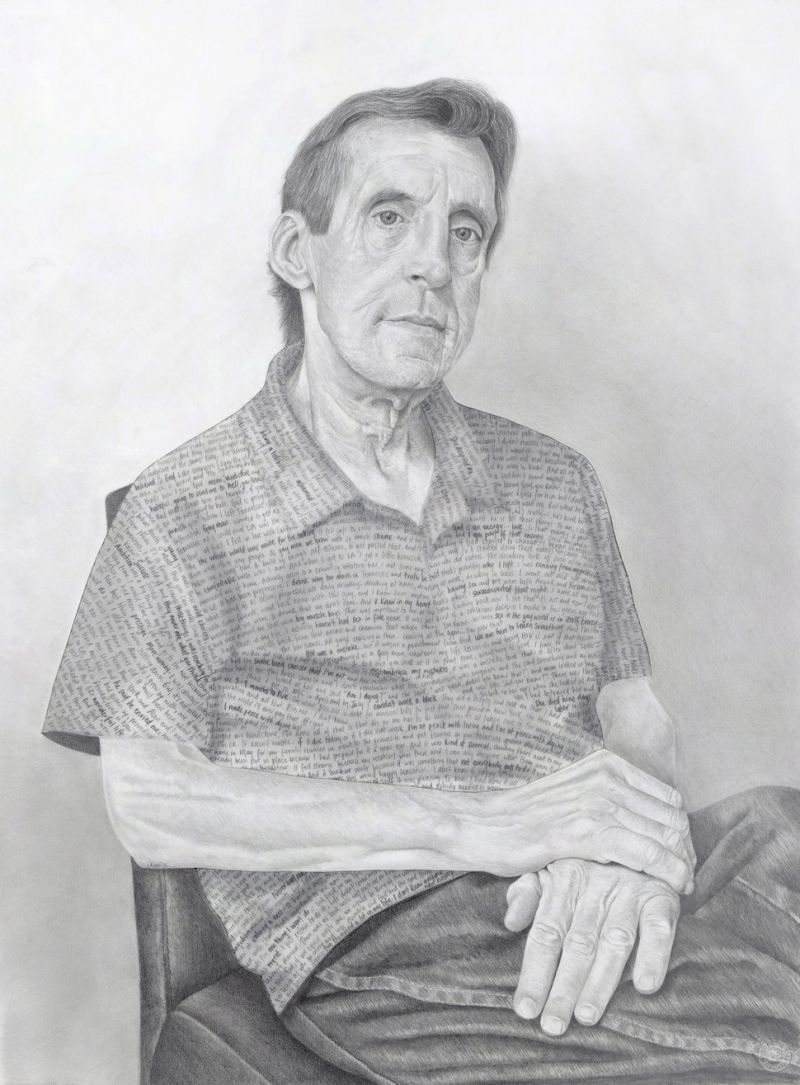
CLAUDIA BICEN, RANDY - PENCIL ON DRAWING AND TISSUE PAPERS - 30” X 22”
“Randy was the first person I interviewed for this project. I met him on Tuesday mornings in his room at Maitri Compassionate Care in Duboce Park, San Francisco. We would sit and talk for about an hour, or until he felt too short of breath due to his lung cancer. The N train would periodically clack down the road outside and there were several pairs of cowboy boots stacked neatly along the wall from Randy’s rodeo days. As a gay man, Randy never felt at home in Tennessee and spent his whole life moving through America’s major liberal cities. Plagued by a nihilism that was pacified by drugs, alcohol and sex, Randy eventually turned to God to find his solace. He told me that it was only through this loving God that he found the strength to forgive himself and accept his life. Randy died on September 27, 2014.”
Now that you’ve finished the project, are you using the lessons you learned in this project in concrete ways? Are you actively trying to live more meaningfully and intensely?
Working on this project has reminded me of the difference between living and being alive, which is, in a sense, like the difference between loving and being in love. I feel in life more. I find myself lost in gratitude much more frequently, whether with my family and friends, out in nature or simply just being alive. I also have found myself much more committed to my life as it is. Not imagining ways in which it could be different or better, but deeply committing to my life and the gifts I have been given.
Part of the intention behind “Thoughts in Passing” was to shine a light onto the darkness that covers death and dying in our culture, and in doing so take away some of the fear surrounding it. This project taught me to shine that same compassionate light onto areas of myself that I have avoided, and in doing so I have been able to be kinder and more accepting of myself.
I don’t mean to suggest that my work will necessarily change you, or even that confronting death necessarily makes people wiser, but I do believe that if you really sit with the messages this work is trying to share, you will find yourself living more deeply.
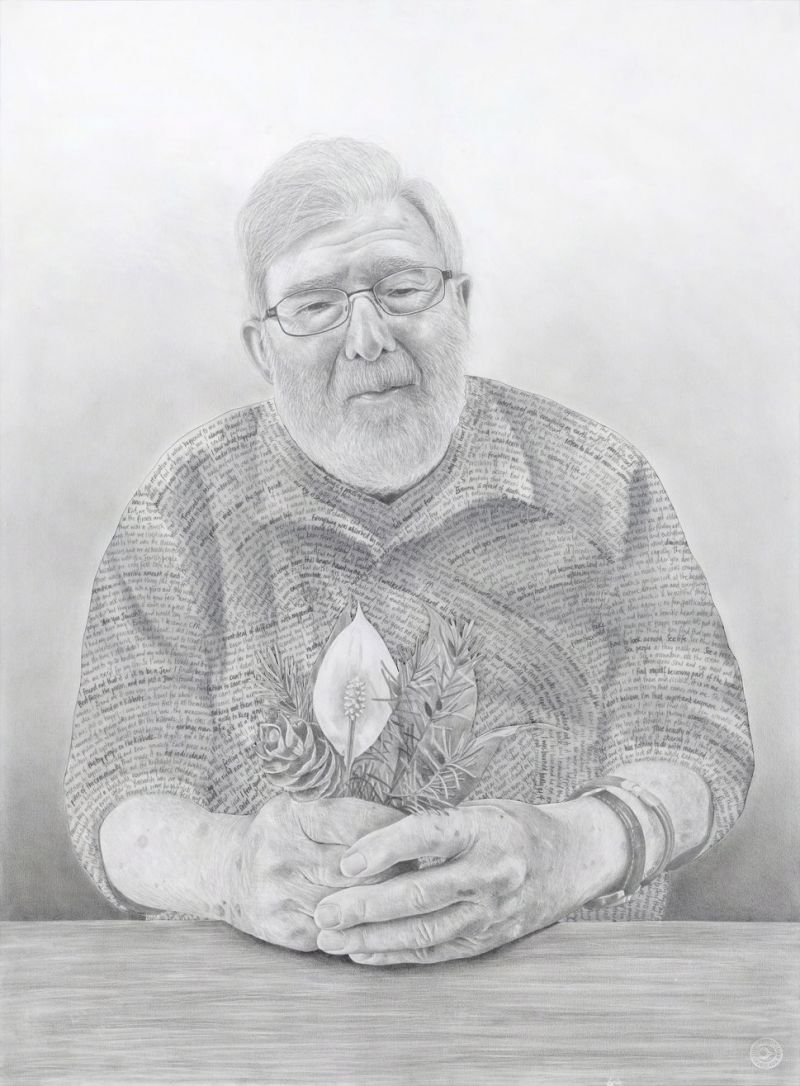 CLAUDIA BICEN, BERT - PENCIL ON DRAWING AND TISSUE PAPERS - 30” X 22”
CLAUDIA BICEN, BERT - PENCIL ON DRAWING AND TISSUE PAPERS - 30” X 22”
“Bert and I met at the Yountville VA Medical Center where he had been moved onto hospice care due to congestive heart failure. On our first meeting Bert gave me a copy of a book he had put together of his paintings and poems. Bert reflected on his life as a Jewish man born in 1920s New York who worked as an accountant and had a wife and three children. With sadness he remembered how he used to be a person who was afraid of the world and getting close to people. For Bert, life really changed at 72 years old when a stroke revealed the memory of a terrible event. Bert shared with me what he found to be left over when he thought he had lost everything – something that had been there all along but he hadn’t had the time to see.”
Finally — Will you continue to stay in touch with your subjects?
Five of the nine people I interviewed for this project have since died. Of the remaining four, I have stayed in touch with either the subjects themselves, their families or social workers. I just found out from Ena’s son that she passed away a couple of week ago, just days before her piece was finished. I regret not being able to share her portrait with her.
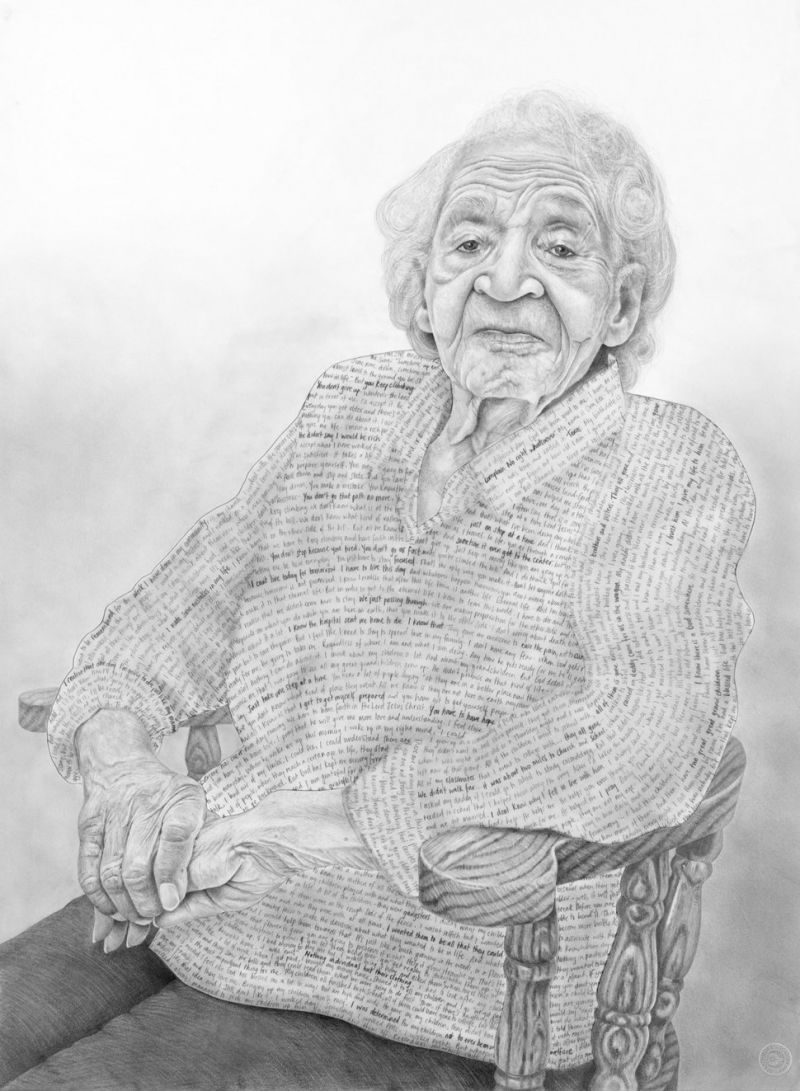 CLAUDIA BICEN, ORA - PENCIL ON DRAWING AND TISSUE PAPERS - 30” X 22”
CLAUDIA BICEN, ORA - PENCIL ON DRAWING AND TISSUE PAPERS - 30” X 22”
“I was introduced to Ora through Pathways Hospice. We met in her home in Portola where she lived with several generations of her family. At 99 years old, Ora was a great-great-grandmother of two and the last living person of her many siblings and school friends. Ora was a staunch believer in resilience and hard work and was proud that each of the generations of her family had more opportunities than the last. At the age of 8, Ora decided to be baptized into Christianity and went on to be an active member of her Church community throughout her life. She attributed her ability to move through life’s challenges to her unwavering faith in God and told me that she had spent her whole life in preparation for the day that God would decide to take her from this earth. Ora died on January 8, 2016.”
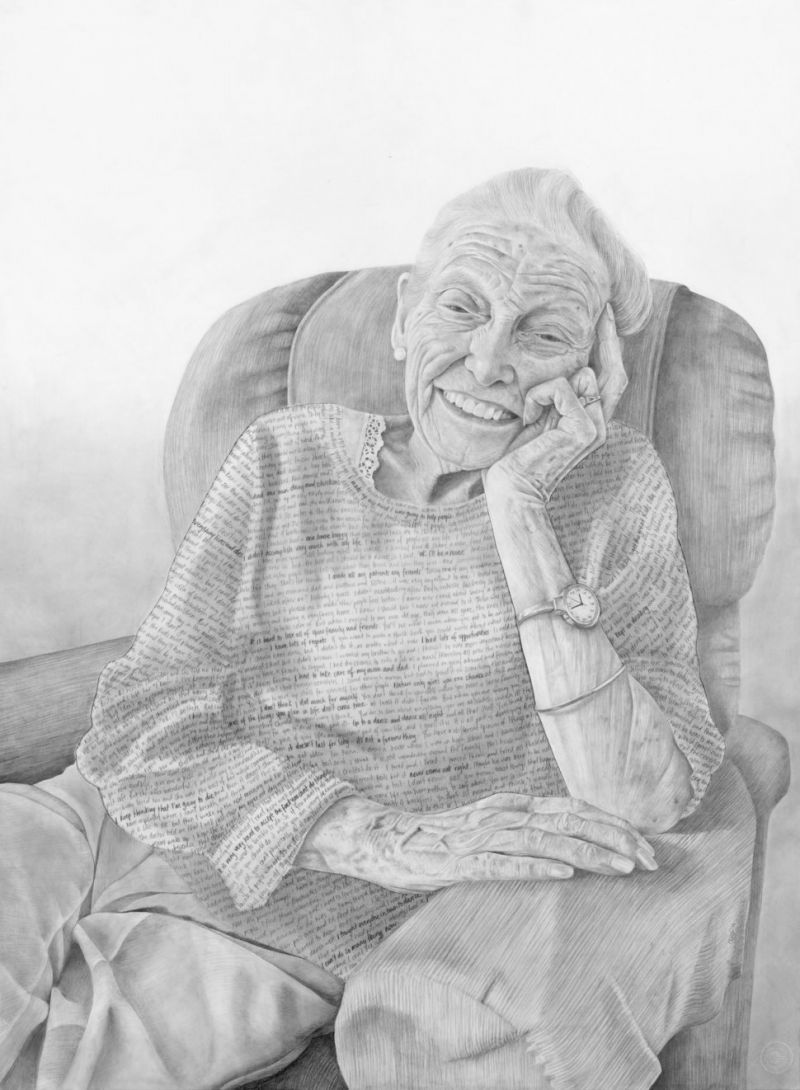 CLAUDIA BICEN, ENA - PENCIL ON DRAWING AND TISSUE PAPERS - 30” X 22”
CLAUDIA BICEN, ENA - PENCIL ON DRAWING AND TISSUE PAPERS - 30” X 22”
“Ena and I met at Vintage Golden Gate in San Francisco where she had been living for a number of years. Ena was always beautiful for our meetings – her hair was done, her nails painted and her jewelry pinned upon her ears and sweater. Ena is the kind of person who calls you “sweetie” and “darling” and makes you feel as though you have always known her. A nurse, Ena was a natural born caretaker; but reflecting back, she realizes that she never made the time and space to follow her own dreams. She was full of regret that she did not take the opportunities that she believed would have made her life more fulfilling and exciting. Even though we met several times, she could never understand why a young person like me wanted to interview her for this project. Ena died on February 20, 2016.”
Syndicated from the Huffington Post. Katherine Brooks is Deputy Enterprise Editor, Culture, HuffPost.
SHARE YOUR REFLECTION
5 Past Reflections


On Apr 10, 2019 Kristin Pedemonti wrote:
As a Storyteller who seeks to serve others to unpack and explore their own inner narrative this piece was especially meaningful to me. Thank you so much for sharing such a deep journey with such care and beauty in reflections on life and death from those at the end of their lives. The drawings are exquisite. <3 So much talent! And thank you for reminding us to share our stories: I appreciate the thoughtfulness with which you shared their own words on their own bodies through the partial transcript written out on their shirts: so clever and so impactful.

On Apr 9, 2019 Virginia Reeves wrote:
Thanks for sharing this interesting and heart-warming excerpt from your project. You validated these people and help others question the outcomes certain choices may have on the future.

On Apr 9, 2019 lynn wrote:
How marvelous and inspiring. What so few of us realize is that we are all dying, just some sooner than others.

On Apr 9, 2019 Patrick Watters wrote:
So much pain, suffering and sadness for many of these. So difficult to hold so much suffering without benefit of Great Love, HOPE. }:- ❤️ anonemoose monk

On Jun 26, 2019 Karen Grace wrote:
Thank you so much for the effort and steadfastness with which you approached and completed this project. Only this morning when a friend pointed out a neighbor who was dying of a brain tumor did I find myself saying that, "we forget we're all dying." So, the timing of reading about your project today from an older issue of Greater Good was fortuitous, The idea to write the words of your people on their clothing is brilliant and such an amazing metaphor, as you intended. Thank you again. Your project has profoundly touched me.
Post Your Reply